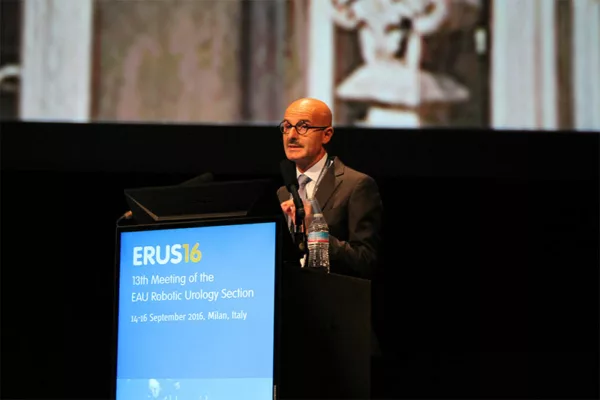ERUS16: Improving post-RARP erectile dysfunction

On the second day of ERUS16, the first of the regular scientific programme, some the leading opinion makers offered their insights to the 750 delegates. Following the mandatory (as per the EAU Policy on Live Surgery) review of the live surgery patients from ERUS15 in Bilbao, an hour was spent offering the audience “pearls from my practice”.
This session offered highly clinically-applicable advice on preparing for RARP, improving urinary continence and erectile function recovery, and reducing the risk of positive surgical margins. The rest of the mornings programme included live surgery by Profs. Mottrie and Patel, and a selection of state-of-the-art lectures. The 13th Meeting of the EAU Robotic Urology Section is taking place in Milan until Friday, September 16th.
Improving erectile function in post-RARP recovery
Prof. Andrea Salonia, a Milan local, spoke extensively on how to improve erectile function recovery following radical prostatectomy. He offered clear recommendations.
“Clinicians should discuss ED prevalence rates, and the limitations and implications of the currently available literature. There is still a great inconsistency in the definition of what is considered normal erectile function before surgery and what one may consider a normal erection after the procedure,” Prof. Salonia began.
“You should also discuss the functional outcomes in men submitted to open versus laparoscopic versus robotic prostatectomy.” Salonia pointed to Ficarra et al (European Urology, 2012), showing a statistically significant advantage in favour of RARP when it came to post-operative potency rates. “Yaxley et al also encourage patients to choose an experienced surgeon they can trust and with whom they have a rapport, rather than a specific surgical approach.”
Further recommendations include giving patients a realistic timeframe for the recovery of erectile function, and discussing post-RP penile rehabilitation as this may have significant potential benefits. Patients must also be made aware that radical prostatectomy is associated with sexual dysfunctions other than ED, including the reduction in libido, changes in orgasm and anejaculation, peyronie’s disease and even penile size changes.
Summarised before his talk and again after, Salonia’s two main messages were: “let’s talk to our patients, and let’s spend a good amount of time with our patients, both pre- and post-radical prostatectomy.”
Live Surgery I
The scientific programme continued with the always-popular live surgery sessions. Procedures were nerve-sparing RARP as performed by Prof. Patel and a robotic partial nephrectomy by Prof. Patel.
